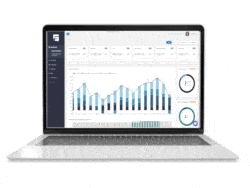Used by hundreds of thousands of small and mid-size businesses nationwide, QuickBooks is a powerful, reliable accounting tool. As an owner, property manager, or accountant for a commercial real estate business, QuickBooks is crucial for keeping good records, making accurate calculations, and even sharing data with your team. However, it’s easy to run into pitfalls and setup issues in QuickBooks when you’re getting started.
Without proper organization, it’s difficult to navigate for the information you need. It can even lead to complications when integrating with property management systems like STRATAFOLIO, preventing you from leveraging these tools to their full effect.
Below are a few of the most common setup issues in QuickBooks we encounter when onboarding new clients at STRATAFOLIO. Read on to learn how you can avoid these major pitfalls.
Chart of Accounts
Issue: Complex, Personalized Account Setup
Sometimes, a QuickBooks setup makes sense to the creator, but is confusing to newcomers. While the original creator may know exactly where everything is, unique or complex setups become a problem when others need to access information. This becomes especially difficult when the employee who did the initial setup is out of the office or moves on from the company, leaving your business with no one who is familiar with your accounting system.
In addition to being a day-to-day inconvenience, extremely personalized account setups can have much higher consequences. Complexity and lack of oversight means that mistakes and even fraud are easier to miss, and audits may be difficult and prolonged.
Solution: Start with a Fresh, Clear Chart of Accounts
A clear and concise chart of accounts (COA) means that anyone can jump in to help if the main user is unavailable. It also allows for easy sharing of information and oversight, preventing errors and fraud.
It may be best to start with an entirely clean set of books. Transferring over year-end balances may be the best solution if converting from Desktop to Online, if there is too much data in the file, or if you have to make an abundance of updates to the account.
Each entity and LLC should have its own QuickBooks file set up. This ensures that there is no commingling of funds, especially if the owner structure is different between entities. Your commercial real estate should also be in its own file if possible. If you have other business activities, it is best to have one QuickBooks file for each type of activity, such as farms, restaurants, or retail stores. These should not be mixed with commercial properties. This way, it is always clear exactly which transactions belong to which parts of your portfolio, creating an easy-to-follow paper trail.
Accounts and Classes
Issue: Too Many Accounts
Having too many general ledger accounts results in a lengthy profit and loss (P&L) statement, making it confusing to read and difficult to search for specific data. It can also lead to higher rates of human error, as it’s harder to tell where to enter and retrieve information.
With STRATAFOLIO, an excessive number of accounts may lead to issues when syncing data from QuickBooks. We typically find that around 100-300 accounts per QuickBooks file is best, depending on the level of detail required for the business.
We also often see multiple Accounts Receivable or Income accounts. There is no need to have one for every customer or tenant who pays you. This is information that QuickBooks runs well without separate accounts.
Similarly, you do not need additional general ledger (GL) accounts for each tenant or unit in order to track them sufficiently in QuickBooks.
Solution: Add Classes Instead of Additional GL Accounts Or Subaccounts
If you need a high level of detail for your business purposes, you can still keep your accounts clear and organized. Instead of creating numerous separate accounts or subaccounts, consider adding classes for greater specificity on your P&L statement. This strategy is simpler and more flexible, allowing you to add multiple assets to a single account.
Classes enable you to easily view both high-level reporting and detailed information as needed. As a general rule, it’s a good idea to use a separate class for each building or asset when adding more than one to a single QuickBooks file.
Customer Setup
Issue: Confusing Addition of Customers and Sub-customers
Another area where it’s easy to add too much information is when adding sub-customers to your customer. Using multiple levels of sub-customers is confusing, both for your team and your software. In STRATAFOLIO, customers are set to a single level. This means that you may not be able to correctly invoice tenants if your setup is more complex. QuickBooks generates separate invoices for each sub-customer, which may result in the same tenant being billed multiple times. It can also make it difficult to find accurate outstanding balances.
Solution: Avoid Unnecessary Detail
Adjust the customer to avoid sub-customers. You will still be able to find all necessary data, and integrated programs like STRATAFOLIO will sync with your data more accurately.
Income
Issue: Too Much or Too Little Specificity for Income
Having too many or too few income items is another common setup issue in QuickBooks. Either way, it can cause problems down the road. Making an income item for each tenant, for example, is far too much detail to sort through efficiently. This also leads to the possibilities of human error when creating invoices.
On the other hand, having only a single income item for all rent and rent-related payments (including common area maintenance, or CAM, charges) doesn’t offer enough information. It becomes impossible to separate out what tenants actually pay for specific services. Without this key data, you can’t accurately perform CAM reconciliations or adjust CAM charges for upcoming years. Not only can this result in lost income, but it can also create distrust between you and your tenants if you struggle to provide accurate, explained CAM reconciliation calculations.
Solution: Find the Middle Ground
While you don’t need a separate income item for every tenant, you also don’t want to have just one. Making CAM charges their own income item keeps them easily visible and distinct from rent payments, but doesn’t clog your systems with unnecessary detail.
Fixing Setup Issues in QuickBooks: A Short Guide
| Category | Issue | Solution |
|---|---|---|
| Chart of Accounts | Too Many Accounts: – Leads to a long, confusing P & L statement – May lead to syncing issues with STRATAFOLIO – Too many A/R accounts lead to confusion | Start with a Fresh, Clear Chart of Accounts: – Give each entity and LLC its own QuickBooks file – Separate CRE from other activities |
| Accounts and Classes | Add Classes Instead: – Classes can be grouped under accounts – See all the details you need while keeping information organized | Too Much or Too Little Specificity: – Income items for each tenant become cumbersome to sort through – Having only a single income item does not offer enough information to catch issues and perform accurate calculations |
| Customer Setup | Confusing Classification of Customers and Sub-customers: – Difficult to find information – May lead to classification issues with STRATAFOLIO – May result in tenants being billed multiple times for the same charge | Avoid Unnecessary Detail: – Do not use sub-customers – The customer classification offers plenty of information |
| Income | Too Much or Too Little Specificity: – Income items for each tenant becomes cumbersome to sort through – Having only a single income item does not offer enough information to catch issues and perform accurate calculations | Find the Middle Ground: – Separate CAM charges from rent for a clear view of who has paid for what |
Learn More About STRATAFOLIO’s Supportive Onboarding Process
Fixing these setup issues in QuickBooks can feel overwhelming, but you’re in the right place to start. Explore more blogs and guides on QuickBooks and accounting best practices to improve your knowledge. To find out how STRATAFOLIO supports you through the onboarding process, including advice on QuickBooks setup, schedule a free 1:1 demo today.






